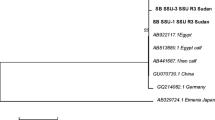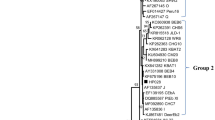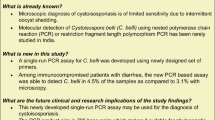Abstract
In this study, we compared and validated a nested ABC polymerase chain reaction restriction fragment length polymorphism (PCR-RFLP) assay to amplify Cryptosporidium parvum oocyst wall protein (COWP) gene fragment with a previous nested PCR-RFLP method. When RFLP of COWP gene did not provide clear results, we further analysed samples by cloning and sequencing for species and genotype identification. ABC-PCR was performed on DNA extracted from human faecal samples collected in England where Cryptosporidium was previously detected by conventional methods. COWP gene amplification was successful for all specimens; RFLP analyses using both RsaI and AluI enzymes recognised 54/55 restriction profiles. Among these, 40 (72.7%) characteristic patterns were generated for C. parvum and six (10.9%) for Cryptosporidium hominis; four (7.3%) showed species mixtures, while the remaining four samples (7.3%) showed atypical genotypes. Cloning and sequencing of mixtures and atypical genotypes identified one C. parvum, one C. hominis and three Cryptosporidium meleagridis. Indeed, molecular tools improved PCR-RFLP results. In conclusion, this study showed that ABC-PCR-RFLP technique was quick, simple and specific. Cloning and sequencing were helpful in characterising mixtures or previously uncharacterised RFLP patterns. All these epidemiological findings are useful information for any preventive intervention to control disease diffusion.

Similar content being viewed by others
References
Altschul SF, Gish W, Miller W, Myers EW, Lipman DJ (1990) Basic local alignment search tool. J Mol Biol 215:403–410
Amar CF, Dear PH, McLauchlin J (2004) Detection and identification by real time PCR/RFLP analyses of Cryptosporidium species from human faeces. Lett Appl Microbiol 38:217–222
Anonymous (1999a) Surveillance of waterborne disease and water quality: January to June 1998. Public Health Lab Serv Commun Dis Rep 9:73–74
Anonymous (1999b) Surveillance of waterborne disease and water quality. January to June 1999, and summary 1999. Public Health Lab Serv Commun Dis Rep 9:305–308
Anonymous (2000) Surveillance of waterborne disease and water quality: July to December 1999. Public Health Lab Serv Commun Dis Rep 10:65–68
Boom R, Sol CJA, Salimans MMM, Jansen CL, Wertheim van Dillen PME, van der Noordaa J (1990) Rapid and simple method for purification of nucleic acids. J Clin Microbiol 28:495–503
Cacciò SM, Thompson RCA, McLauchlin J, Smith HV (2005) Unravelling Cryptosporidium and Giardia epidemiology. Trends Parasitol 21:430–437
Cama VA, Bern C, Sulaiman IM, Gilman RH, Ticona E, Vivar A, Kawai V, Vargas D, Zhou L, Xiao L (2003) Cryptosporidium species and genotypes in HIV-positive patients in Lima, Peru. J Eukaryot Microbiol 50:531–533
Carraway M, Tzipori S, Widmer G (1997) A new restriction fragment length polymorphism from Cryptosporidium parvum identifies genetic heterogeneous parasite populations and genetic changes following transmission from bovine to human hosts. Infect Immun 65:3958–3960
Dawson D (2005) Foodborne protozoan parasites. Int J Food Microbiol 103:207–227
Feltus DC, Giddings CW, Schneck BL, Monson T, Warshauer D, McEvoy JM (2006) Evidence supporting zoonotic transmission of Cryptosporidium spp. in Wisconsin. J Clin Microbiol 44:4303–4308
Gòmez-Couso H, Freire-Santos F, Amar CF, Grant KA, Williamson K, Ares-Mazas ME, McLauchlin J (2004) Detection of Cryptosporidium and Giardia in molluscan shellfish by multiplexed nested-PCR. Int J Food Microbiol 91:279–278
Gòmez-Couso H, Amar CFL, McLauchlin J, Ares-Mazás E (2005) Characterisation of a Cryptosporidium isolate from water buffalo (Bubalus bubalis) by sequencing of a fragment of the Cryptosporidium oocyst wall protein gene (COWP). Vet Parasitol 131:139–144
Hashimoto A, Hitomi S, Shigemitsu M, Tsuyoshi H (2006) Genotyping of single Cryptosporidium oocysts in sewage by semi-nested PCR and direct sequencing. Water Res 40:2527–2532
McLauchlin J, Pedraza-Díaz S, Amar-Hoetzeneder C, Nichols GL (1999) Genetic characterization of Cryptosporidium strains from 218 patients with diarrhea diagnosed as having sporadic cryptosporidiosis. J Clin Microbiol 37:3153–3158
McLauchlin J, Amar C, Pedraza-Díaz S, Nichols GL (2000) Molecular epidemiological analysis of Cryptosporidium spp. in the United Kingdom: results of genotyping Cryptosporidium spp. in 1,705 fecal samples from humans and 105 fecal from livestock animals. J Clin Microbiol 38:3984–3990
Pedraza-Dìaz S, Amar C, Nichols GL, McLauchlin J (2001) Nested polymerase chain reaction for amplification of the Cryptosporidium oocyst wall protein gene. Emerg Infect Dis 7:49–56
Samie A, Bessong PO, Obi CL, Sevilleja JE, Stroup S, Houpt E, Guerrant RL (2006) Cryptosporidium species: preliminary descriptions of the prevalence and genotype distribution among school children and hospital patients in the Venda region, Limpopo Province, South Africa. Exp Parasitol 114:314–322
Sturbaum GD, Reed C, Hoover PJ, Jost BH, Marshall MM, Sterling CR (2001) Species-specific, nested PCR-restriction fragment length polymorphism detection of single Cryptosporidium parvum oocysts. Appl Environ Microbiol 67:2665–2668
Sulaiman IM, Xiao L, Lal AA (1999) Evaluation of Cryptosporidium parvum genotyping techniques. Appl Environ Microbiol 65:4431–4435
Sunnotel O, Lowery CJ, Moore JE, Dooley JSG, Xiao L, Millar BC, Rooney PJ, Snelling WJ (2006) Cryptosporidium. Lett Appl Microbiol 1:7–16
Trotz-Williams LA, Martin DS, Gatei W, Cama V, Peregrine AS, Martin SW, Nydam DV, Jamieson F, Xiao L (2006) Genotype and subtype analyses of Cryptosporidium isolates from dairy calves and humans in Ontario. Parasitol Res 99:346–352
Widmer G (1998) Genetic heterogeneity and PCR detection of Cryptosporidium parvum. Adv Parasitol 40:223–239
Xiao L, Fayer R, Ryan U, Upton SJ (2004) Cryptosporidium taxonomy: recent advances and implications for public health. Clin Microbiol Rev 17:72–97
Acknowledgements
We acknowledge the collaboration and comments from Dr. Corinne F.L. Amar, Geraldine Leong, Dr Jim McLauchlin and Dr. Andrew Montgomery Thomson (Health Protection Agency Centre for Infections, London). Dr. Andrew Montgomery Thomson’s present address is the Stem Cell and Developmental Biology, Genome Institute of Singapore.
The experiments comply with the current laws of the country where they were performed.
Author information
Authors and Affiliations
Corresponding author
Rights and permissions
About this article
Cite this article
Leone, A., Ripabelli, G., Sammarco, M.L. et al. Detection of Cryptosporidium spp. from human faeces by PCR-RFLP, cloning and sequencing. Parasitol Res 104, 583–587 (2009). https://doi.org/10.1007/s00436-008-1233-8
Received:
Accepted:
Published:
Issue Date:
DOI: https://doi.org/10.1007/s00436-008-1233-8




